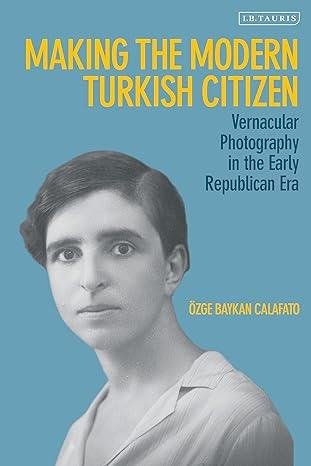Making the Modern Turkish Citizen: Vernacular Photography in the Early Republican Era
The early Republican era in Turkey was a time of profound transformation. The newly founded Republic of Turkey, under the leadership of Mustafa Kemal Atatürk, sought to modernize the nation and redefine its identity. A crucial aspect of this transformation was the creation of the modern Turkish citizen, a concept that was not just political but also cultural. "Making the Modern Turkish Citizen: Vernacular Photography in the Early Republican Era" is a comprehensive exploration of how everyday photography played a pivotal role in this process. This article delves into the book's insights, examining how vernacular photography helped shape national identity and modern citizenship in Turkey during this transformative period.
The Role of Photography in Early Republican Turkey
Photography, as a medium, has always been a powerful tool for documenting and shaping reality. In the context of early Republican Turkey, photography was used not just to capture moments but to construct a new national narrative. The book argues that vernacular photography, which includes everyday, non-professional images taken by ordinary people, was instrumental in disseminating the ideals of modernity and nationalism.
Creating a New National Identity
Atatürk's reforms aimed to break away from the Ottoman past and create a secular, modern nation-state. This involved a series of radical changes, including the adoption of the Latin alphabet, the introduction of new laws, and a strong emphasis on Westernization. Photography played a key role in documenting these changes and promoting the new national identity. Images of men in Western suits, women without veils, and modern architecture were circulated widely, helping to ingrain these new ideals into the public consciousness.
Everyday Life as a Canvas
Vernacular photography provided a unique perspective on the everyday lives of Turkish citizens during this period of transition. Family portraits, street scenes, and snapshots of daily activities revealed how ordinary people were experiencing and contributing to the modernization process. These images are invaluable historical documents that show the nuanced ways in which modernity was negotiated in daily life. They also reflect the tensions and contradictions inherent in such a rapid transformation.
Gender and Modernity
One of the key themes explored in the book is the role of gender in the construction of modern citizenship. The early Republican era saw significant changes in the status and roles of women. Vernacular photography from this period often depicts women in new, modern roles—working in offices, attending schools, and participating in public life. These images were crucial in challenging traditional gender norms and promoting the idea of the modern Turkish woman as an active participant in the nation-building process.
Urbanization and Modern Spaces
The rapid urbanization of Turkey during the early Republican era is another significant theme. The book examines how vernacular photography captured the transformation of urban spaces. New buildings, roads, and public spaces were not just physical changes but symbols of progress and modernity. Photographs of bustling cities, modern infrastructure, and new public amenities helped to create a sense of a modern, forward-looking nation.
The Politics of Representation
The book also delves into the politics of representation and how certain images were used to construct a specific narrative of modernity. The state played a crucial role in this process, using photography as a tool for propaganda. Official photographs often depicted idealized images of progress and modernity, while vernacular photographs provided a more complex and sometimes contradictory view. This interplay between official and vernacular photography highlights the contested nature of national identity and modern citizenship.
The Impact of Vernacular Photography
The impact of vernacular photography on the construction of modern Turkish citizenship cannot be overstated. These images provided a visual language through which people could understand and relate to the changes happening around them. They also allowed for a more inclusive and diverse representation of the nation, capturing the experiences of ordinary people from different backgrounds and regions.
Preserving History Through Photography
The book emphasizes the importance of preserving these photographic archives as they offer invaluable insights into the social and cultural history of Turkey. Vernacular photographs are not just personal mementos but historical documents that provide a rich and textured understanding of the past. They help us see how modernity was lived and experienced by ordinary people, offering a bottom-up perspective on historical change.
"Making the Modern Turkish Citizen: Vernacular Photography in the Early Republican Era" is a seminal work that sheds light on the crucial role of photography in the nation-building process. By examining the everyday images captured by ordinary people, the book provides a nuanced and multifaceted view of how modern Turkish citizenship was constructed and experienced. Vernacular photography, with its ability to capture the mundane and the extraordinary, offers a unique window into the complexities of modernity and national identity. This book is an essential read for anyone interested in the social and cultural history of Turkey, as well as the power of photography as a tool for shaping and understanding the past.
